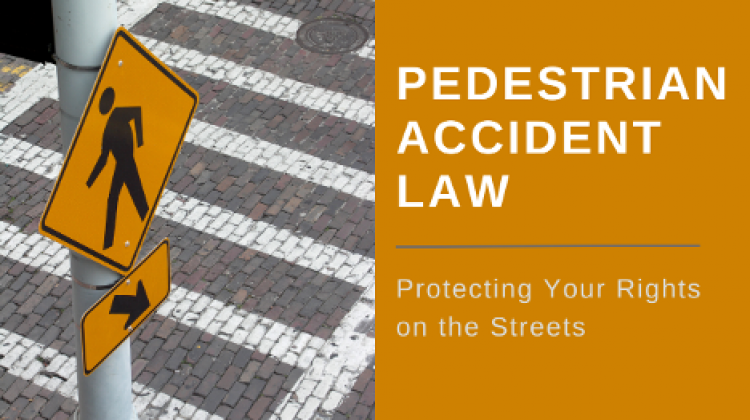Many Massachusetts residents, especially in cities like Boston, prefer to walk if they need to get to work, go shopping, or run errands. However, pedestrian accidents are still common, and they often result in severe injuries or even fatalities.
Understanding your rights and the legal landscape surrounding pedestrian accidents is crucial for protecting yourself and your loved ones. In many pedestrian accident cases, working with a Boston personal injury attorney is necessary to achieve justice. This article will explore the key aspects of pedestrian accident law in Massachusetts, providing you with essential information to safeguard your interests.

The Scope of Pedestrian Accidents in Massachusetts
Pedestrian accidents remain a significant concern in the Bay State. In 2023, there were about 2,400 accidents involving pedestrians in Massachusetts, 63 of which resulted in fatal injuries. These accidents can occur in various settings, from bustling city streets to quieter suburban neighborhoods.
Common causes of pedestrian accidents include:
- Distracted driving
- Failure to yield right-of-way
- Speeding
- Impaired driving
- Poor visibility
- Inadequate infrastructure.
Understanding Your Rights as a Pedestrian
In Massachusetts, pedestrians have specific rights protected by law. These rights are designed to ensure safety and establish clear guidelines for both pedestrians and motorists. Some key rights include:
| Right | Explanation |
| Right-of-way at crosswalks | Drivers must yield to pedestrians in marked and unmarked crosswalks. |
| Sidewalk priority | Pedestrians have the right-of-way on sidewalks. |
| Walking against traffic | When there’s no sidewalk, pedestrians should walk on the left side of the road, facing oncoming traffic. |
| Reasonable care | Motorists must exercise reasonable care to avoid colliding with pedestrians. |
It’s important to note that pedestrians also have responsibilities, such as obeying traffic signals and using designated crosswalks when available.
Liability in Pedestrian Accidents
Determining liability in these cases can be complex. Massachusetts follows a modified comparative negligence rule, which means that compensation can be reduced based on the degree of fault assigned to each party. If a pedestrian is found to be more than 50% at fault for the accident, they may be barred from recovering damages.
Factors that can influence liability include:
- Adherence to traffic laws
- Visibility and lighting conditions
- Road design and maintenance
- Weather conditions
- Driver and pedestrian behavior.
Given the complexity of liability issues, it’s often advisable to consult with a personal injury attorney experienced in such cases.
Compensation for Pedestrian Accident Victims
Those injured in a pedestrian accident can receive various forms of compensation, such as compensation for:
- Medical expenses (current and future)
- Lost wages and loss of earning capacity
- Pain and suffering
- Emotional distress
- Rehabilitation costs
- Property damage.
The amount of compensation can vary significantly based on the severity of injuries, long-term impact, and other factors specific to your case.
Insurance Considerations
The driver’s Personal Injury Protection (PIP) insurance often provides initial coverage for the injured pedestrian’s medical expenses and lost wages, typically up to $8,000. For severe injuries or when expenses exceed PIP limits, pedestrians may file a claim against the driver’s liability insurance. The pedestrian’s own auto, health, or homeowner’s insurance might also apply in certain situations.
Statute of Limitations
In Massachusetts, the statute of limitations for filing a personal injury lawsuit related to such accidents is generally three years from the date it happened. It is critical to understand this timeline. Failure to file within the statutory deadline may result in the loss of your right to seek compensation.

Steps to Take After a Pedestrian Accident
Take the following steps to protect your rights and create a stronger foundation for your potential claim:
- Seek medical attention at once, even if your injuries seem minor.
- Report the accident to the police and secure a copy of the report.
- Gather contact and insurance information from the driver involved.
- Collect contact information from any witnesses.
- If possible, take photos of the scene.
- Save proofs of all medical treatments and expenses.
- Avoid discussing fault or giving recorded statements to insurance companies without legal counsel.
- To ensure you get just compensation, consult with a lawyer experienced in handling such accidents.
The Importance of Legal Representation
While not every pedestrian accident case requires an attorney, having experienced legal representation can be invaluable, especially in cases involving severe injuries or disputed liability. A skilled personal injury lawyer can:
- Navigate complex legal and insurance processes
- Gather and preserve crucial evidence
- Negotiate with insurance companies on your behalf
- Accurately value your claim, including future damages
- Represent you in court if a fair settlement cannot be reached.
To Sum Up
By knowing your rights, taking appropriate steps after an accident, and seeking professional legal guidance when necessary, you can navigate the aftermath of a pedestrian accident with confidence. Remember, your safety on the streets is paramount, but should an accident occur, you have legal recourses to protect your interests and well-being.
If you want to avoid the hassle of the legal processes, contact Michael Kelly Injury Lawyers by calling (617) 444-4444. Their expertise can be the key to a successful settlement for you.

